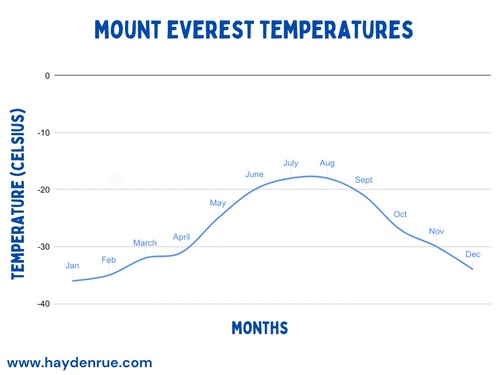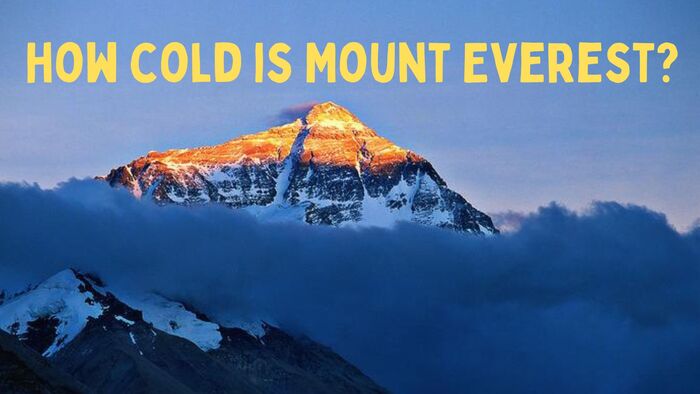Mount Everest, the world’s highest peak, is not only renowned for its elevation but also for its extreme and fluctuating temperatures. Temperatures at the summit are freezing and during January temperatures can drop as low as -60° C (-76° F). Despite Everest having low temperatures the biggest issue faced by climbers are hurricane force winds and wind chill.
When the jet stream dips south during the winter hurricane force winds may develop reaching more than 285 km/h (177 mph). These winds relax in the month of May and most climbers try to attempt the peak during this short window.
Ranging from bone-chilling cold to surprisingly warm intervals, the temperatures on Mount Everest serve as a captivating study in the intricacies of high-altitude weather systems. This article delves into various Mount Everest temperatures, exploring the diverse factors that influence its thermal profile and the profound implications these fluctuations carry for mountaineering inquiry.
Temperatures at Mount Everest

The coldest temperatures on Mount Everest happen from the middle of December until the end of January. Throughout this period, the summit witnesses an average temperature of approximately -37°C (-35°F), while the temperatures at Everest Base Camp level out at an average of -17°C (1.4°F).
As spring takes hold in April and May, temperatures experience a swift ascent, creating a climate suitable for t-shirts during the day, albeit with chilly nights. It’s pretty normal to see climbers wearing t-shirts up to camp 3 at this time. In May, when there’s a short time for climbing to the summit, the average temperatures are about -15°F and -26°C.
Additionally, National Geographic has also developed a website with low bandwidth, offering climbers on Everest easy access to data from the Everest Weather Station Network. This near-real-time site allows climbers to view the latest weather information conveniently on their smartphones, even from Base Camp or higher up the mountain.
Everest’s Strong Winds and Extreme Conditions

The summit of Everest stands as a contender for the windiest location on Earth, experiencing hurricane-force winds for more than 50% of days during the windiest months. This meteorological phenomenon is particularly from mid-October through early April, where the winds at the summit consistently surpasses 74 mph, equivalent to the wind speeds of a Category 1 Hurricane.
Throughout the winter period, wind chill-adjusted temperatures at the summit plummet to a chilling -70°C (-90°F). It is an extreme so severe that exposed skin would succumb to frostbite almost instantaneously at this temperature. The arrival of May brings with it lower wind speeds and warmer temperatures, accounting for the relatively brief window of opportunity for climbing.
The combination of wind chill, frigid temperatures, and the soaring elevation makes Everest’s summit one of the most uninviting places on the planet during the winter. The wind chill-adjusted temperatures as low as -70°C (-90°F) witnessed at the summit can be compared to the chilling conditions of the world’s coldest spots, such in Siberia recorded -67.8°C (-90°F) and the -89°C (-129°F) at Vostok in Antarctica.
How Low Can The Temperature Get On Mt. Everest?

During January, the cold Mount Everest temperatures become especially noticeable, with average lows spanning from 8 to 12 degrees Celsius. Throughout this month, the winter season holds its grip, leading to a swift drop in temperatures.
During the morning fog often envelops the mountain during January, while days remain brisk and clear. Nights, however, witness a significant temperature plummet along the peak. The combination of wind chill and tropical storms renders the summit unwelcoming during the winter season.
This period is marked by scarce precipitation, yet it experiences intense winter storms, ice pellets, and substantial snowfall. As the trail ascends from the base camp, temperatures notably decrease, occasionally dipping below -36 degrees Celsius.
Shifting jet streams from the northern to the southern hemisphere brings about strong winds and heavy snowfall. These shifts can bring devastating hurricanes with speeds reaching up to 285 mph on Mount Everest. More commonly, wind speeds hover around 160 km/h, still posing a considerable threat. These forces have the strength to deter mountaineers and obstruct their path to the summit.
During winter, the average temperatures on Mount Everest range from approximately -37 to -34 degrees Fahrenheit. Everest Base Camp experiences slightly milder conditions, with nighttime temperatures hovering between -5 to -12 degrees Celsius, while daytime temperatures rise to around 4 degrees Celsius.
Factors Contributing to Mount Everest’s Temperature

It’s widely known that Mount Everest experiences the coldest temperatures on Earth. The temperature can drop as low as -36 degrees Celsius, making the area extremely cold. Surprisingly, even during the summer, temperatures remain below -19 degrees Celsius. This is why climbers wear highly insulated clothing when ascending Everest, even in the summer.
This raises the question of why Everest’s temperature is so low.
Several factors contribute to Everest’s extremely low temperature, mainly its high altitude and the season. The height of Everest ranges from 5,360 m at base camp to 8,848 m above sea level at the summit, where the oxygen levels are very low.
Climbers do use oxygen bottles to breathe, but the supply only lasts about five hours, so they need to ascend quickly in the “death zone.” Spending too much time in the area can lead to conditions like heart stroke, cerebral edema and death.
Navigating Everest’s Changing Temperatures:

The changing seasons also play a role in the temperature differences on Mount Everest. In winter, the temperature on Everest drops by as much as -17 degrees Celsius compared to summer. Because of this, most climbers avoid attempting the ascent in winter and opt for spring or autumn.
Many adventurers aim for the Everest summit in spring due to the warmer weather and the mountain’s relative tranquility. As jet streams shift northward in March and April, the mountain becomes calmer by May.
What makes climbing Mount Everest in spring appealing is that climbers can tackle the peak even when faced with windstorms blowing at speeds of up to 35 mph. However, not everyone can withstand such extreme conditions, and some climbers may decide to cancel their expedition.
The location you’re in while trekking on the mountain also affects the temperature. If you haven’t ventured too far from the base camp, the temperature in March typically ranges between 12 and 20 degrees Celsius.
Temperature Dynamics on Everest: Winter Chill and Seasonal Winds
During winter, the temperature gradually drops, falling below -17 degrees Celsius. As you progress towards the mountain via the Khumbu glacier, the temperature decreases rapidly, noticeable by the swift transformation into icy-cold conditions.
When the Siberian air streams shifts over the Tibetan Plateau, temperatures can plummet to as low as -60 degrees Celsius. In summer, the wind remains relatively calm, making it more manageable to traverse the trail through steep-sided gullies, valleys, and the Lhotse face.
What Temperatures Do Mountaineers Encounter on Mount Everest?

The summit experiences perpetually freezing temperatures, and in January, the temp can plummet to a frigid -60°C (-76°F). Despite the bone-chilling cold, climbers are predominantly challenged by the formidable hurricane-strength winds and the biting wind chill.
Even on what might be considered the warmest day of the year, temperatures on the trail to the summit don’t climb above 0 degrees Celsius. While Mount Everest maintains its icy demeanor year-round, winter stands out as the most challenging season weather-wise.
Autumn Season:
Autumn is considered the second season of choice as it offers favorable weather for climbing Mount Everest. Despite nightly frost at the top, most days are marked by warmth and sunshine without snowfall. From mid-September, temperatures gradually decline until winter arrives on the mountain.
The trail remains considerably colder than the Everest Base Camp, covered in thick ice sheets and glaciers. Autumn is characterized by strong winds and shorter days, presenting challenges for climbers. While temperatures can dip below freezing, they are not as extreme as in the winter. The weather remains fairly stable for approximately two months before the onset of winter.
Spring Season:
Spring is the preferred choice for trekking on Everest because of its pleasant weather. Unlike the rainy monsoon season, spring has mild temperatures, making it easier for climbers to handle the cold. March marks the beginning of this season, and while temperatures rise slowly, they still stay below freezing.
In April and May, strong winds blow from the west at speeds of 50mph against the mountain. This leads to lower air pressure and less available oxygen for climbers. Spring weather is somewhat cold and dry, attracting moist air that can sometimes lead to storms.

Winter Season:
Nepal’s winter lasts from late December to February, which brings freezing cold weather and hailstorms. On Mount Everest, temperatures can plummet to as low as -36 degrees Celsius.
The intense cold is too much for most climbers to handle, especially while navigating the paths to the summit. Additionally, climbers need to deal with the constant threat of avalanches. Winter often brings wild storms and heavy snowfall, leading to flight delays or cancellations at Lukla as well.
Summer-Monsoon Season:
The summer-monsoon weather happens due to the Indian Monsoon, bringing a humid climate and frequent rainfall. Mountaineers might face winds gusting at speeds of up to 100 km/h. With the sudden rise in temperatures, rockslides and falling rocks are common in the summer. The increase in moisture from the sea surface to the upper atmosphere results in heavy rain.
During summer, the temperature on Mount Everest remains much colder than at the Base Camp, ranging from 20 to 25 degrees Celsius. As you go higher, the air gets less humid, which could lead to rain. However, even in summer, the mountain’s temperature remains cold, dropping below 0 degrees Celsius. Even on a sunny day, the temperature on Everest can be as low as -3 degrees Celsius due to low air pressure. At the summit, temperatures can drop to -19 degrees Celsius in July.
Is There A Weather Station on Mt Everest?

In 2019, a group led by climate scientists Tom Matthews and Baker Perry set up a weather station on Mount Everest’s Balcony. Positioned at around 8,430 meters (27,657 feet) above sea level, this weather station is the highest of its kind globally. It’s located just a few hundred meters below Everest’s summit, which stands as the highest point on Earth.
The weather tracking system, using energy from the sun, is designed to measure different weather patterns, like the air temperature, wind speed and direction, how the snow’s surface changes, and incoming and outgoing short and long-wave radiation.
